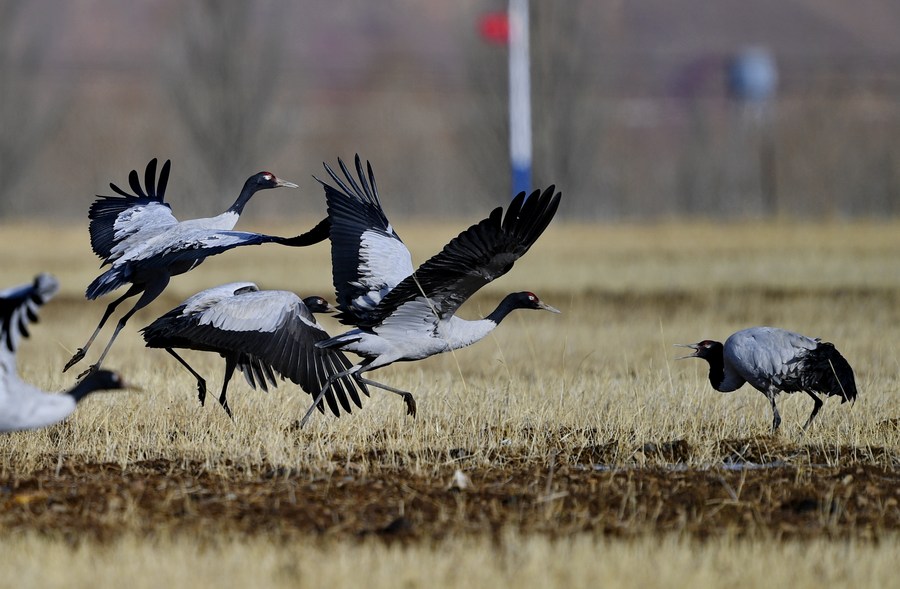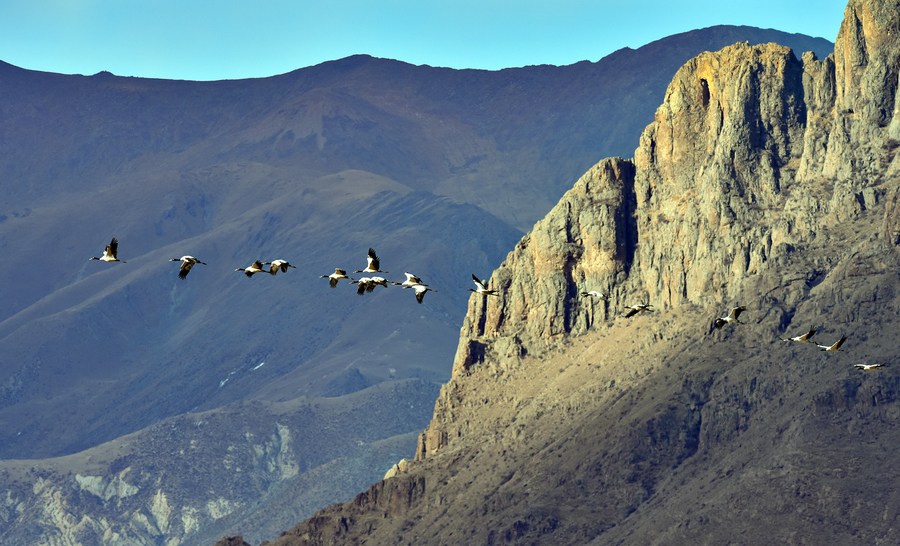Source:Xinhua 2023-09-15

Black-necked cranes fly in Lhunzhub County of Lhasa, southwest China's Tibet Autonomous Region, Jan. 9, 2022. (Xinhua/Zhang Rufeng)
LHASA, Sept. 13 (Xinhua) -- Upon graduation from university, Yang Le signed up for a volunteer program to aid the development of southwest China's Tibet Autonomous Region. He initially intended to broaden his horizons and gain some work experience, but he became engrossed in the program's environmental work and wound up staying for 18 years.
Yang, 41, is now deputy director of Tibet Plateau Institute of Biology. The intense sunlight on the plateau has turned his skin a darker shade, while his cheeks are rosy due to the high altitude.
Though hailing from central China's Hunan Province, he has dedicated most of his time to biological research and environmental protection on the Qinghai-Tibet Plateau, also known as the "roof of the world." He has paid particular attention to the black-necked crane, a species under first-class state protection in China.
"My teacher at university once told me that there was much work to be done in this vast world, offering plenty of scope for developing my skills. He said Tibet was a land in need of development, so I decided to come here," Yang said.
With a university education in biology and a keen interest in wildlife, Yang found Tibet the ideal place to put his talents to use.

Black-necked cranes sport at a field in Lhunzhub County of Lhasa, southwest China's Tibet Autonomous Region, Jan. 8, 2022. (Xinhua/Zhang Rufeng)
Over the past two decades, he has visited all the 74 counties across Tibet to observe the habitats and migration paths of the black-necked crane, helping to protect the endangered species.
"The black-necked crane is a flagship species in Tibet, and its protection is quite important for the local ecosystem," he said.
Having spent so long observing the rare cranes, Yang has developed a special affection for the species.
"They are just like my own kids. A male black-necked crane only has one mate during its whole life. And watching them get married, have babies and migrate safely makes me happy," Yang said.
Over the years, Yang has come up with multiple suggestions on how to improve the protection of the species. These include the establishment of nature reserves and building infrastructure to support the cranes in their habitats, aiming to strike a balance between human activities and ecological preservation.

Black-necked cranes fly in Lhunzhub County of Lhasa, southwest China's Tibet Autonomous Region, Jan. 8, 2022. (Xinhua/Huang Huo)
Thanks to the efforts of Yang and his colleagues, over 70 black-necked crane observation areas have been established in Tibet. The population of the species has gradually increased over the years, rising from under 3,000 in 1995 to over 10,000 now.
The local Tibetan people are very fond of the black-necked crane, which they often call the "fairy crane," "divine bird" or "auspicious bird."
Yang has managed to motivate more local residents to join his cause. In Lhunzhub, a county located near the mid-reaches of the Yarlung Zangbo River and a core protection area for the black-necked cranes, wildlife rangers and local people have reached a consensus on helping the endangered wild animal wherever they can.
"Nature is always the guiding principle," said Yang. "I will stay on here, continuing to seek more value from life."
Copyright © Xizang Daily & China Xizang News All rights reserved
Reproduction in whole or in part without permissions prohibited
Index Code: 藏 ICP 备 05000021 号
Producer: Xizang Daily International Communication Center